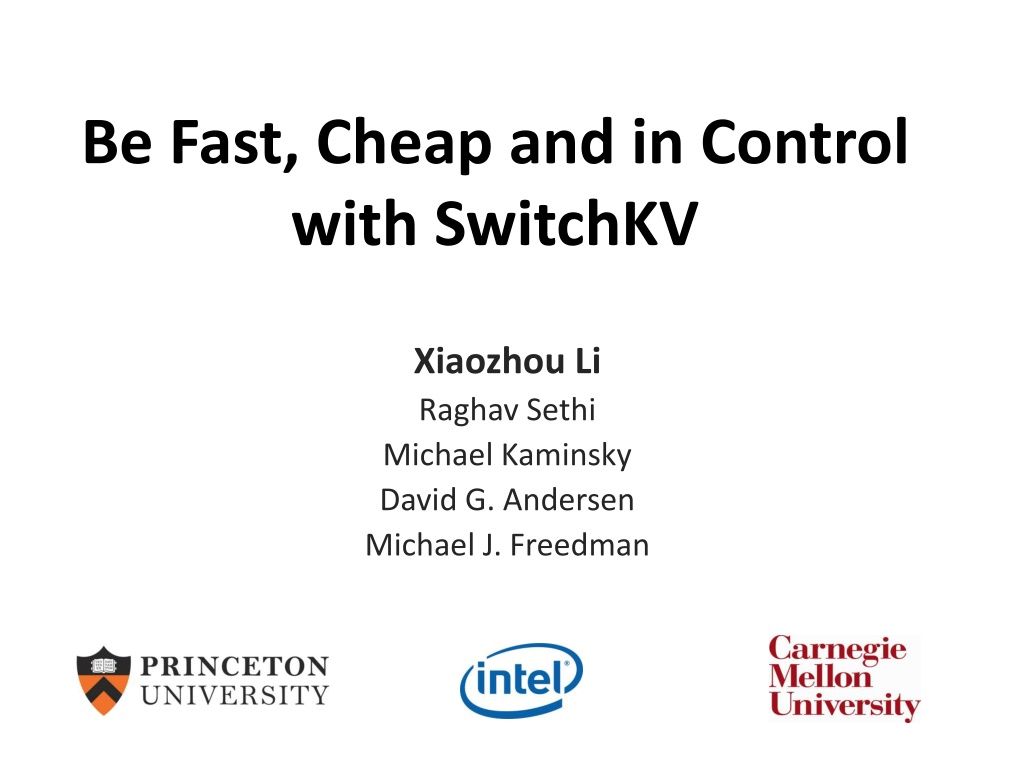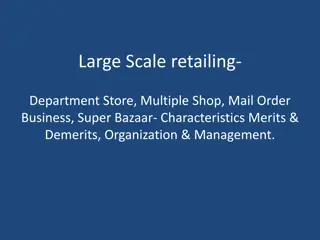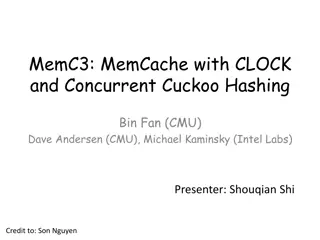Enhancing Key-Value Store Efficiency with SwitchKV
Explore how SwitchKV optimizes key-value store performance through content-aware routing, minimizing latency, and enabling efficient load balancing. By leveraging SDN and switch hardware, SwitchKV offers a fast, cost-effective solution for dynamic workloads in modern cloud services, overcoming challenges like data migration and replication system overhead. Learn how small caches and cluster-level storage are utilized to enhance throughput and availability, making it a reliable choice for managing massive numbers of key-value objects.
Download Presentation

Please find below an Image/Link to download the presentation.
The content on the website is provided AS IS for your information and personal use only. It may not be sold, licensed, or shared on other websites without obtaining consent from the author. Download presentation by click this link. If you encounter any issues during the download, it is possible that the publisher has removed the file from their server.
E N D
Presentation Transcript
Be Fast, Cheap and in Control with SwitchKV Xiaozhou Li Raghav Sethi Michael Kaminsky David G. Andersen Michael J. Freedman
Goal: fast and cost-effective key-value store Target: cluster-level storage for modern cloud services Massive number of small key-value objects Highly skewed and dynamic workloads Aggressive latency and throughput performance goals This talk: scale-out flash-based storage for this setting 2
Key challenge: dynamic load balancing time t time t+x How to handle the highly skewed and dynamic workloads? Today s solution: data migration / replication system overhead consistency challenge 3
Fast, small cache can ensure load balancing Need only cache O(nlogn)items to provide good load balance, where nis the number of backend nodes.[Fan, SOCC 11] hottest queries less-hot queries, better-balanced loads flash-based backend nodes frontend cache node E.g., 100 backends with hundreds of billions of items + cache with 10,000 entries How to efficiently serve queries with cache and backend nodes? How to efficiently update the cache under dynamic workloads? 4
High overheads with traditional caching architectures clients clients miss backends cache (load balancer) backends cache Look-through Look-aside Cache must process all queries and handle misses In our case, cache is small and hit ratio could be low Throughput is bounded by the cache I/O High latency for queries for uncached keys 5
SwitchKV: content-aware routing clients cache controller OpenFlow Switches backends Switches route requests directly to the appropriate nodes Latency can be minimized for all queries Throughput can scale out with # of backends Availability would not be affected by cache node failures 6
Exploit SDN and switch hardware Clients encode key information in packet headers Encode key hash in MAC for read queries Encode destination backend ID in IP for all queries Switches maintain forwarding rules and route query packets hit L2 table Packet Out to the cache Packet In exact match rule per cached key miss TCAM table Packet Out match rule per physical machine 7
Keep cache and switch rules updated New challenges for cache updates Only cache the hottest O(nlogn) items Limited switch rule update rate Goal: react quickly to workload changes with minimal updates top-k <key, load> list (periodic) switch rule update fetch <key, value> cache backend controller bursty hot <key, value> (instant) 8
Evaluation How well does a fast small cache improve the system load balance and throughput? Does SwitchKV improve system performance compared to traditional architectures? Can SwitchKV react quickly to workload changes? 9
Evaluation Platform Reference backend 1 Gb link Intel Atom C2750 processor Intel DC P3600 PCIe-based SSD RocksDB with 120 million 1KB objects 99.4K queries per second 10
Evaluation Platform Xeon Server 1 Xeon Server 2 # of backends 128 Cache Client 40 GbE Ryu backend tput 100 KQPS 40 GbE keyspace size 10 billion 40 GbE 40 GbE Pica8 P-3922 (OVS 2.3) key size 16 bytes 40 GbE 40 GbE value size 128 bytes 40 GbE 40 GbE query skewness Zipf 0.99 cache size 10,000 entries Backends Xeon Server 3 Backends Xeon Server 4 Default settings in this talk Use Intel DPDK to efficiently transfer packets and modify headers Client adjusts its sending rate, keep loss rate between 0.5% and 1% 11
Throughput with and without caching Backends aggregate (without cache) Backends aggregate (with cache) Cache (10,000 entries) 12
Throughput vs. Number of backends backend rate limit: 50KQPS, cache rate limit: 5MQPS 13
Throughput with workload changes Traditional cache update method Periodic top-k updates only Periodic top-k updates + instant bursty hot key updates Make 200 cold keys become the hottest keys every 10 seconds 15
Conclusion SwitchKV: high-performance and cost-efficient KV store Fast, small cache guarantees backend load balancing Efficient content-aware OpenFlow switching Low (tail) latency Scalable throughput High availability Keep high performance under highly dynamic workloads 16























